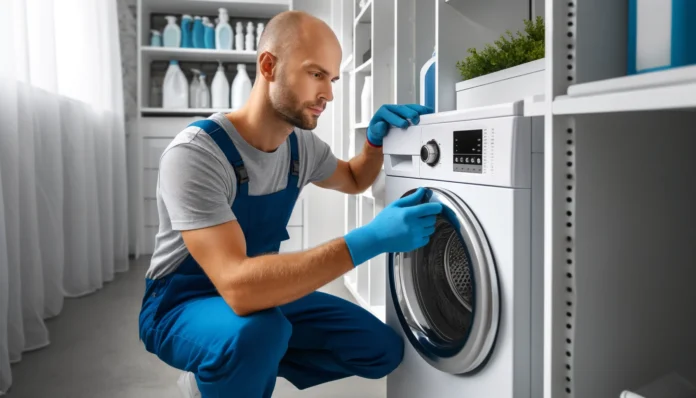Are you tired of paying hefty repair bills for your washing machine? With this comprehensive guide, you’ll learn how to troubleshoot and fix common washer problems yourself, saving money and extending the life of your appliance. We’ll cover everything from diagnosing issues to step-by-step repair instructions, along with essential maintenance tips to keep your washer running smoothly.
Why DIY Washing Machine Repair?
Fixing your washing machine yourself offers several advantages:
- Cost Savings: Avoid expensive service calls and repair fees.
- Convenience: Tackle problems on your own schedule, without waiting for a technician.
- Empowerment: Gain valuable skills and knowledge about appliance repair.
- Appliance Longevity: Regular maintenance can significantly extend the life of your washer.
Before you start any repairs, always prioritize safety. Unplug the washing machine and turn off the water supply to prevent electrical shocks or water damage.
Common Washing Machine Problems & How to Fix Them
Let’s dive into the most frequent washing machine issues and their solutions:
1. Washing Machine Won’t Start
If your washer refuses to turn on, check the following:
- Power Supply: Ensure the washer is plugged in and the outlet is working.
- Lid Switch/Door Lock: These safety mechanisms prevent the washer from operating if the lid or door is open. Inspect them for damage or misalignment.
- Timer/Electronic Control Board: If the previous checks don’t reveal the issue, the timer or control board might be faulty. Consider consulting a professional for these repairs.
2. Washing Machine Won’t Drain
A washer that doesn’t drain can lead to a soggy mess. Here’s what to do:
- Drain Hose: Inspect the drain hose for clogs, kinks, or blockages. Clean it out if necessary.
- Pump Filter: Locate and clean the pump filter, which can accumulate debris and prevent proper drainage.
- Kinks or Blockages: Check for any kinks or blockages in the drain hose or pump.
3. Washing Machine is Leaking
Water leaks can damage your floor and create a safety hazard. Investigate these areas:
- Hoses: Examine the inlet and drain hoses for cracks, leaks, or loose connections. Tighten or replace them as needed.
- Pump: A faulty pump can lead to leaks. Check for damage and replace it if necessary.
- Tub Seal/Door Gasket: Inspect these seals for wear and tear. Replace them if they’re damaged.
4. Washing Machine is Noisy
Excessive noise can indicate various problems:
- Motor: A worn-out or damaged motor can produce loud noises. If you suspect the motor, it’s best to call a professional.
- Pump: A noisy pump might be clogged or damaged. Clean the pump filter or replace the pump if needed.
- Bearings: Worn-out bearings can create grinding or squealing sounds. Replacing them requires disassembling the washer, so consider professional help.
5. Washing Machine Won’t Spin
If your washer fills with water but doesn’t spin, check these components:
- Drive Belt: Inspect the drive belt for wear, damage, or slippage. Replace it if necessary.
- Motor Coupler: This part connects the motor to the transmission. If it’s broken, the washer won’t spin.
- Lid Switch/Door Lock: A malfunctioning switch or lock can prevent the spin cycle. Test them for continuity and replace them if needed.
Step-by-Step Washing Machine Repair Guide
- Gather Tools and Materials: You’ll need screwdrivers, wrenches, a multimeter, and any replacement parts you’ve identified.
- Turn Off Power and Water: Unplug the washer and shut off the water valves.
- Access the Problem Area: Refer to your washing machine manual for guidance on removing panels or covers.
- Diagnose the Problem: Use visual inspection and a multimeter to test electrical components.
- Repair or Replace Parts: Follow the manufacturer’s instructions for repairs or replacements.
- Reassemble and Test: Put everything back together and run a test cycle to ensure your repairs were successful.
When to Call a Professional
While many washing machine repairs can be DIY projects, some situations require professional expertise:
- Complex Electrical Issues: If you’re not comfortable working with electrical components, leave it to the experts.
- Gas-Powered Washers: Gas appliances require specialized knowledge and should only be serviced by qualified technicians.
- Water Leaks: If you can’t identify the source of a leak or it seems extensive, call a plumber or appliance repair service.
Washing Machine Maintenance Tips
Keep your washer in top shape with these maintenance tips:
- Clean the Pump Filter Regularly: This prevents clogs and ensures proper drainage.
- Inspect Hoses: Check for leaks, cracks, or wear and tear. Replace hoses as needed.
- Level the Washing Machine: An unlevel washer can vibrate excessively and cause damage.
- Use the Correct Detergent: Follow the manufacturer’s recommendations for detergent type and amount.
- Avoid Overloading: Overloading puts stress on the motor and other components.
By following this guide and performing regular maintenance, you can keep your washing machine running smoothly for years to come.
Remember: Always prioritize safety when working with appliances. If you’re unsure about any repair, don’t hesitate to consult a professional.



